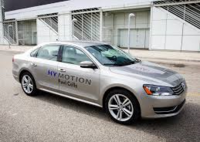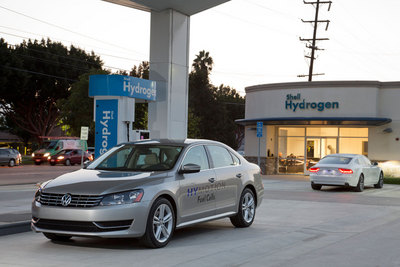Driving Impression: Volkswagen Passat HyMotion and Audi A7 h-tron Fuel Cell Prototypes
• SEE ALSO: The Auto Channel Hydrogen Fuel Cell News Library; 6598 Citations (1997-2015)
• SEE ALSO: How Fuel Cells Work
By Henny Hemmes
Senior European Editor
December 31,2014- The Fuel Cell Vehicle is well set into our automotive future. The large car manufacturers are all in the process of developing such cars and especially during the past year, they have shown concepts, production ready models and prototypes; article here
The Volkswagen Group shipped prototypes of the Passat HyMotion and the Audi A7 h-tron to Los Angeles for test drives to demonstrate what has been achieved so far.
 |
Mr. Kahlich said he expect hydrogen cars to go into series production in the next decade: “Hydrogen makes sense when it is produced by renewable energy. We can produce it with natural gas, but the CO2 emission is comparable to that of petrol. In that case, we would have more expensive vehicles, but no benefit. Energy has to come from solar, wind or water works. If there is surplus energy, it has to be stored, grid has to be built, may be holes in the ground…”
Like the Passat HyMotion, also the Audi A7 h-tron quattro has 170 kW/228 hp and 540 Nm of torque. However, the Passat has a 1.1 kWh battery pack, much smaller and lighter than the 8.8 kWh unit in the Audi. Moreover, the Audi concept has quattro all-wheel-drive, thanks to the second electric motor that drives the rear wheels. In both models, the electric motor(s) are powered directly by the fuel cell or the lithium ion battery. The tanks are placed in the back, mostly underneath the luggage compartment.
Apart from the (weight) difference of the battery packs, there is also the difference in kerb weight of both cars: de A7 is some 1,100 pounds heavier than the Passat and you can feel that when driving.
We did not have enough time to take both cars to the limit. But that was not the intention of the Volkswagen Group. The Germans just wanted to show us that fuel cell technology is on the horizon, that prototypes are tested and can be built and that they can look good, just like your favorite daily driver.
And that like other hybrid cars, that FCVs will be easy to drive.. It is highly likely that, in the next decade, when the infrastructure is developing and other problems are solved, Volkswagen will start to offer a well-balanced and nice HyMotion variant of its then most popular models, undoubtedly the Golf and the Passat. It is a fair bet that Audi will focus more on sporty customers with its quattro models, as show with the A7 h-tron prototype.
.



